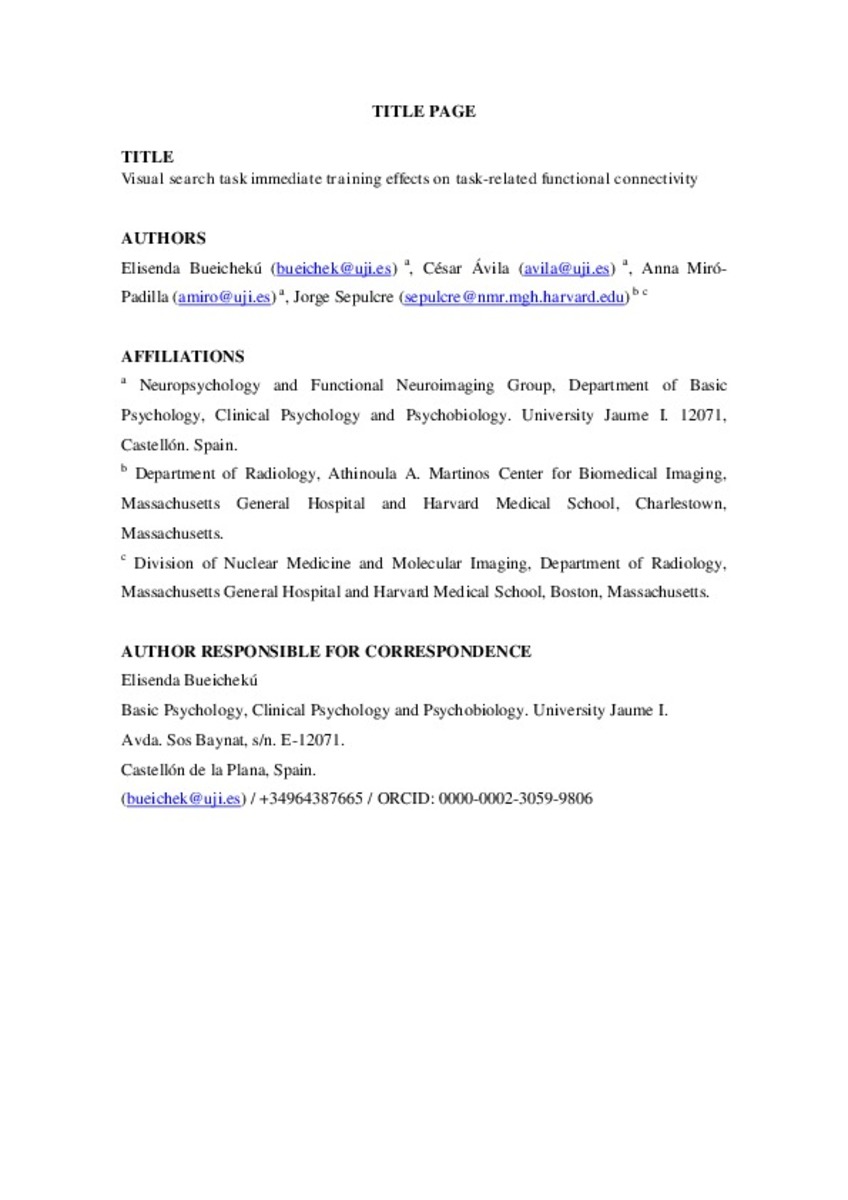Mostrar el registro sencillo del ítem
Visual search task immediate training effects on task-related functional connectivity
| dc.contributor.author | Bueichekú, Elisenda | |
| dc.contributor.author | Avila, Cesar | |
| dc.contributor.author | Miró-Padilla, Anna | |
| dc.contributor.author | Sepulcre, Jorge | |
| dc.date.accessioned | 2019-05-28T06:56:31Z | |
| dc.date.available | 2019-05-28T06:56:31Z | |
| dc.date.issued | 2018 | |
| dc.identifier.citation | Bueichekú, E., Ávila, C., Miró-Padilla, A. et al. Brain Imaging and Behavior (2019) 13: 1566. https://doi.org/10.1007/s11682-018-9993-y | ca_CA |
| dc.identifier.issn | 1931-7557 | |
| dc.identifier.issn | 1931-7565 | |
| dc.identifier.uri | http://hdl.handle.net/10234/182593 | |
| dc.description | This is a pre-print of an article published in [ Brain Imaging and Behavior. The final authenticated version is available online at: https://doi.org/10.1007/s11682-018-9993-y | |
| dc.description.abstract | Brain plasticity occurs over the course of the human lifetime. Learning and training modify our neuronal synapses and adapt our brain activity, from priming effects in modal areas to higher-order changes in the association cortex. The current state of the art suggests that learning and training effects might induce large-scale brain connectivity changes. Here, we used task-fMRI data and graph-based approaches to study the immediate brain changes in functional connections associated with training on a visual search task, and the individual differences in learning were studied by means of brain-behavior correlations. In a previous work, we found that trained participants improved their response speed on a visual search task by 31%, whereas the control group hardly changed. In the present study, we showed that trained individuals changed regional connections (local links) in cortical areas devoted to the specific visual search processes and to areas that support information integration, and largely modified distributed connections (distant links) linking primary visual areas to specific attentional and cognitive control areas. In addition, we found that the individuals with the most enhanced connectivity in the dorsolateral prefrontal cortex performed the task faster after training. The observed behavioral and brain connectivity findings expand our understanding of large-scale dynamic readjustment of the human brain after learning experiences. | ca_CA |
| dc.format.extent | 14 p. | ca_CA |
| dc.language.iso | eng | ca_CA |
| dc.publisher | Springer | ca_CA |
| dc.rights | © Springer Science+Business Media, LLC, part of Springer Nature 2018 | ca_CA |
| dc.rights.uri | http://rightsstatements.org/vocab/InC/1.0/ | * |
| dc.subject | attention | ca_CA |
| dc.subject | cognitive training | ca_CA |
| dc.subject | functional connectivity | ca_CA |
| dc.subject | functional magnetic resonance imaging | ca_CA |
| dc.subject | graph-theory | ca_CA |
| dc.subject | visual search task | ca_CA |
| dc.title | Visual search task immediate training effects on task-related functional connectivity | ca_CA |
| dc.type | info:eu-repo/semantics/article | ca_CA |
| dc.identifier.doi | https://doi.org/10.1007/s11682-018-9993-y | |
| dc.relation.projectID | PSI2016-78805-R / Spanish Department of Economy and Competitiveness; PSI2013-47504-R / Spanish Department of Economy and Competitiveness; FPI prgram for PhD / Universitat Jaume I; Postdoctoral researcher grant / Universitat Jaume I; FPU program for PhD / Department of Education (ES); FPU research stay grant / Department of Education (ES) | ca_CA |
| dc.rights.accessRights | info:eu-repo/semantics/openAccess | ca_CA |
| dc.relation.publisherVersion | https://link.springer.com/article/10.1007/s11682-018-9993-y | ca_CA |
| dc.type.version | info:eu-repo/semantics/submittedVersion | ca_CA |
Ficheros en el ítem
Este ítem aparece en la(s) siguiente(s) colección(ones)
-
PSB_Articles [1294]
Articles de publicacions periòdiques







